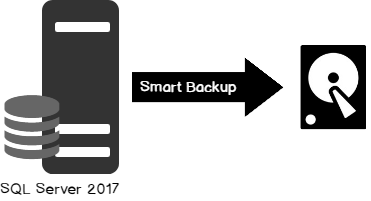So far, we’ve discussed several phases of backup that starts with planning, creating, strategizing and implementing. In this article, we are going to see how database administrators can define the strategy to improve backup performance and efficiently manage backups in SQL Server 2017. The following are the topics of discussion:
- Discuss checkpoints
- Discuss the enhancements made in the Dynamic Management View (DMV) sys.dm_db_file_space_usagefor smart differential backups
- Discuss the enhancements made for the Dynamic Management function (DMF) sys.dm_db_log_stats for smart transactional log backup
- Understand the functioning of smart differential backup and its internals
- Understand the Smart transaction log backup process and its internals
- T-SQL scripts
- And more…

Background
A checkpoint is a background process that writes dirty pages to disk. A checkpoint performs a full scan of the pages in the buffer pool, lists all the dirty pages that are yet to be written to the disk, and finally writes those pages to the disk. In SQL instances that do not have many dirty pages in the buffer pool, this is a trivial operation. However, with the SQL instances that have OLTP databases, use more memory and/or involve sequential scanning of all pages, the performance of the system could be impacted.
With SQL Server 2012, indirect checkpoints were introduced. In this case, the dirty page manager manages the dirty page list and generally keeps tracks of the all the dirty pages modifiers of the database. By default, it runs every 60 seconds and tracks the dirty pages that need to be flushed.
For example, if an indirect checkpoint is set to 120 seconds then individual pages would be flushed around 120 seconds after that they were made dirty. This will impact I/O. I/O also depends on the number of dirty modifiers lists of the database; we may even see a significant spike in the set target interval and see small hits as the pages change. This eliminates overhead to tracing and flushing the dirty pages which result in significant improvement in backup performance. To review further, go to the reference section below to understand more about the checkpoint and backup performance improvement process in detail.
On a database where an automatic checkpoint mode is set, tracing of the entire unit of the buffer pool is necessary to evaluate for possible dirty pages. On the other hand, with an indirect checkpoint, only those pages of the buffer pool that are dirtied have to be dealt with.
For example, let’s consider a system with 2 TB of memory that contains ~250 million buffer units and has 100 dirty pages. Assume that it requires 5 CPU cycles to trace and identify the status of each buffer unit. To traverse 250 million BUFs, it would require 1.25 trillion CPU cycles—and to what? Simply to find 100 positive dirty pages in the automatic checkpoint mode! However, 100 dirty pages are hardly anything with the indirect checkpoint mode. The entire buffer pool scanning time is eliminated.
further reading smart database backup
Happy learning!


